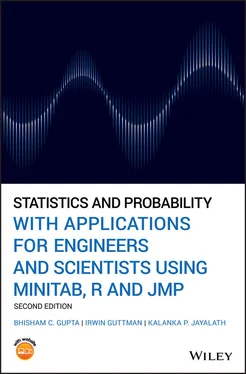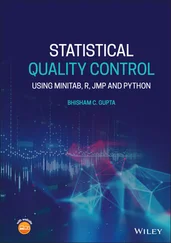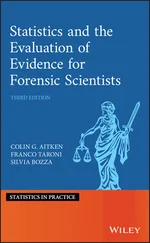Other resources on the book website www.wiley.com/college/gupta/statistics2e available for download include: Solutions Manualto all odd numbered homework exercises in the text.
The following resources are available to adopting instructors on the textbook website: www.wiley.com/college/gupta/statistics2e.
Solutions Manual to all homework exercises in the text.
Lecture slides to aid instructors preparing for lectures.
Data sets for all examples and homework exercises from the book, in three formats: Minitab, Microsoft Excel, and JMP.
ErrataWe have thoroughly reviewed the text to make sure it is as error‐free as possible. However, any errors discovered will be listed on the textbook website. If you encounter any errors as you are using the book, please send them directly to the authors bcgupta@maine.edu, so that the errors can be corrected in a timely manner on the website, and for future editions. We also welcome any suggestions for improvement you may have, and thank you in advance for helping us improve the book for future readers.
We are grateful to the following reviewers and colleagues whose comments and suggestions were invaluable in improving the text:
Zaid Abdo, University of Idaho
Erin Baker, University of Massachusetts
Bob Barnet, University of Wisconsin‐Platteville
Raj Chhikara, University of Houston, Clear Lake
Prem Goel, Ohio State University
Boetticher, Gary D, University of Houston, Clear Lake
Mark Gebert, University of Kentucky
Subir Ghosh, University of California, Riverside
Ramesh Gupta, University of Maine
Rameshwar Gupta, University of New Brunswick, Canada
Xiaochun Jiang, North Carolina Agricultural and Technical State University
Dennis Johnston, Baylor University
Gerald Keller, Joseph L. Rotman School of Management, University of Toronto
Kyungduk Ko, Boise State University
Paul Kvam, Georgia Institute of Technology
Bin Li. Louisiana State University
Thunshun Liao, Louisiana State University
Jye‐Chyi Lu, Georgia Institute of Technology
Sumona Mondal, Clarkson University
Janbiao Pan, California Poly State University
Anastassios Perakis, University of Michigan
David Powers, Clarkson University
Ali Touran, Northeastern University
Leigh Williams, Virginia Polytechnic and State University
Tian Zheng, Columbia University
Jingyi Zhu, University of Utah
We thank William Belcher, Darwin Davis, Julie Ellis, Pushpa Gupta, Mohamad Ibourk, James Lucas, Mary McShane‐Vaughn, Louis Neveux, and Phil Ramsey who helped find suitable data sets for the case studies. We also thank Laurie McDermott for her help in typing some parts of this manuscript. Special thanks are due to Eric Laflamme for helping write JMP/Excel procedures and creating PowerPoint presentations, George Bernier for helping write Excel work books and macros, and Patricia Miller and Brenda Townsend for editing Power Point Slides and some parts of the manuscript. We appreciate Terry Scott and Chamila Meetiyagoda for reviewing R codes and new edition of the manuscript.
We acknowledge Minitab Inc. and SAS Institute Inc. for permitting us to print MINITAB and JMP screenshots in this book. We also acknowledge the R Core team for allowing us to use open access R software.
Portions of the text are reproduced with permission from the American Society for Quality (ASQ), Applied Statistics for the Six Sigma Green Belt and Statistical Quality Control for the Six Sigma Green Belt by Gupta and Fred Walker (2005, 2007).
We would also like to express our thanks and appreciation to the individuals at John Wiley, for their support, confidence, and guidance as we have worked together to develop this project.
The authors would like to gratefully thank their families. Bhisham acknowledges the patience and support of his wife, Swarn; daughters, Anita and Anjali; son, Shiva; sons‐in‐law, Prajay and Mark; daughter‐in‐law, Aditi; and wonderful grandchildren, Priya, Kaviya, Ayush, Amari, Sanvi, Avni and Dylan. For their patience and support, Irwin is grateful to his wife, Mary; son, Daniel; daughters, Karen and Shaun; wonderful grandchildren, Liam, Teia, and Sebastian; brothers and their better halves, Alvin and Rita, and Stanley and Gloria. Kalanka appreciates the support of his wife, Chamila; daughters, Nesandi and Minudi.
BHISHAM GUPTA
IRWIN GUTTMAN
KALANKA JAYALATH
This book is accompanied by a companion website:

www.wiley.com/college/gupta/statistics2e
The website includes materials for students and instructors:
Instructors
Chapters 20 and 21
Data sets
PowerPoint presentations
Complete solutions manual
Certain proofs and derivations
Some statistical tables
JMP files
R exhibits
Students
Chapters 20 and 21
Data sets
Partial solutions Manual
Certain proofs and derivations
Some statistical tables
JMP files
R exhibits
Statistics, the discipline, is the study of the scientific method. In pursuing this discipline, statisticians have developed a set of techniques that are extensively used to solve problems in any field of scientific endeavor, such as in the engineering sciences, biological sciences, and the chemical, pharmaceutical, and social sciences.
This book is concerned with discussing these techniques and their applications for certain experimental situations. It begins at a level suitable for those with no previous exposure to probability and statistics and carries the reader through to a level of proficiency in various techniques of statistics.
In all scientific areas, whether engineering, biological sciences, medicine, chemical, pharmaceutical, or social sciences, scientists are inevitably confronted with problems that need to be investigated. Consider some examples:
An engineer wants to determine the role of an electronic component needed to detect the malfunction of the engine of a plane.
A biologist wants to study various aspects of wildlife, the origin of a disease, or the genetic aspects of a wild animal.
A medical researcher is interested in determining the cause of a certain type of cancer.
A manufacturer of lenses wants to study the quality of the finishing on intraocular lenses.
A chemist is interested in determining the effect of a catalyst in the production of low‐density polyethylene.
A pharmaceutical company is interested in developing a vaccination for swine flu.
A social scientist is interested in exploring a particular aspect of human society.
In all of the examples, the first and foremost work is to define clearly the objective of the study and precisely formulate the problem. The next important step is to gather information to help determine what key factors are affecting the problem. Remember that to determine these factors successfully, you should understand not merely statistical methodology but relevant nonstatistical knowledge as well. Once the problem is formulated and the key factors of the problem are identified, the next step is to collect the data. There are various methods of data collecting. Four basic methods of statistical data collecting are as follows:
A designed experiment
A survey
An observational study
A set of historical data, that is, data collected by an organization or an individual in an earlier study
Читать дальше













